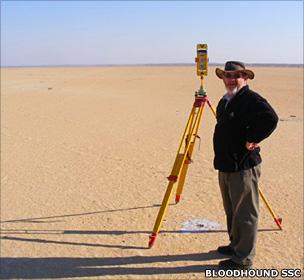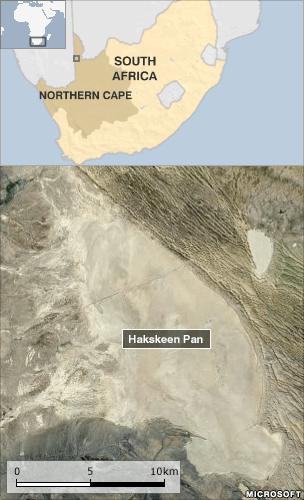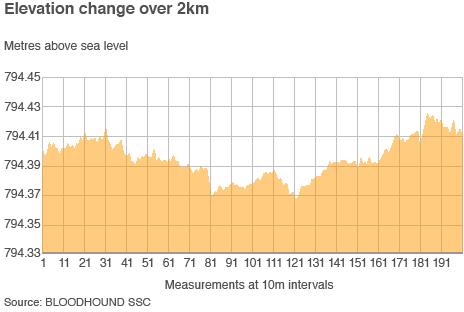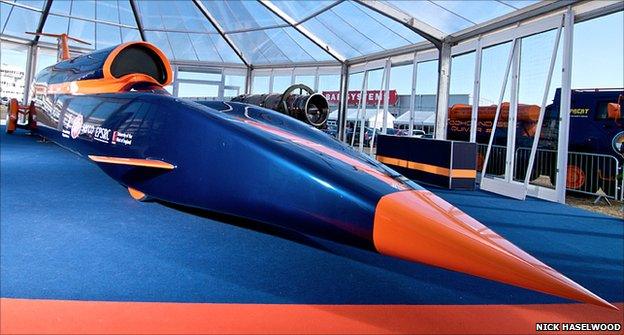Bloodhound diary: How flat is flat?
- Published
RAF fighter pilot Andy Green intends to get behind the wheel of a car that is capable of reaching 1,000mph (1,610km/h). Powered by a rocket bolted to a Eurofighter-Typhoon jet engine, the Bloodhound car will mount an assault on the land speed record.
The record bid will take place on Hakskeen Pan, Northern Cape Province, South Africa, in 2012.
Wing Cmdr Green is writing a diary for the BBC News Website about his experiences working on the Bloodhound project and the team's efforts to inspire national interest in science and engineering.
DOING SOME MATHS

On the pan: A survey requirement for 200 points, each 10m apart
One thing we want to know about the run site for the Bloodhound Supersonic Car (SSC) is "How flat is it?" - or perhaps more accurately "How bumpy is it?"
I've driven on it in a hire car and it looks and feels flat - but a small undulation at 80-plus mph could be a huge bump at 800-plus mph.
We need to know if there are going to be any nasty surprises out there at 1,000 mph.
We also need to know how hard the suspension and chassis will have to work.
How much suspension travel will we need if there are any significant bumps? What sort of frequencies will the suspension see? Are any of these frequencies anywhere near the "natural" frequencies of the car and suspension? (in which case the motion of the car could become uncontrollable - which would be bad!).
Once all of the desert preparation work, external is completed, some time next year, we will check the whole track from end to end for any bumps that might cause us trouble. In the meantime, we need to have a rough idea of how flat (or bumpy) the surface is, to help with designing the car and its suspension.
Thanks to the fantastic level of help that we are getting in South Africa, we now have some data.

The Northern Cape team surveyed a 2km stretch of desert, adjacent to the our chosen track, to give us an indication of vertical variation over this length.
Why 2km? We want to make sure that we do not have any inputs near the suspension frequency of the car (around 2.5Hz: see the vehicle technical spec, external for more detail).
If we look for inputs at a tenth of this rate or more, we will spot any possible problems. A tenth of 2.5 is 0.25Hz - a quarter of an oscillation a second, or one every four seconds.
At 1,000 mph, the car will travel 1,800m in four seconds - so call it 2km. And how many points do we need along this 2km strip? We chose a nominal upper limit of 10 Hz for this study, and the effects only start to get interesting above 200mph - say 100m/s. 10Hz at 100m/s means a survey point every 10m.
Hence we have the survey task. Measure the vertical height (as accurately as possible) at 200 points, 10m apart in a 2km long straight line, on a representative part of the desert.
This is one of the tasks that our South African team carried out recently and we are hugely grateful to them. It may not be glamorous, but it's a key part of getting this right. Turning up in South Africa with a suspension that doesn't work is really not a good look - and this will help to make sure that we don't.
These results are surprising, in a very good way. Total variation over the 2km strip? It's tiny - just 61mm. This is a very flat desert.

The above graph may look like the surface of the Moon, but just imagine stretching that line out until it's 2,000m long - it would be so flat that it would look perfect.
In fact, as we've seen on the pan, it is so flat that it looks perfect. Now we know just how flat. It's another indication that Hakskeen Pan is the ideal place for the world's first 1,000 mph race track.

The full size, full length Bloodhound SSC model car was unveiled at the recent Farnborough Air Show
- Published13 August 2010